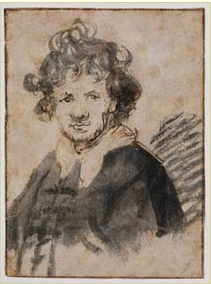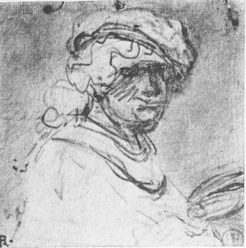DRAWING SKILLS
PART 4
Project 7 Self Portrait
Exercise 4 Research point
Investigate some artists self portraits. Look at well known self portraits –such as Rembrandt and Van Gogh and lesser known artists. Make notes in your learning log.
It is easy to find a Rembrandt self portrait on the internet but it is harder to find a Rembrandt self portrait that is a drawing rather than a print or etching, I found only three of these.

Figure 1 Rembrandt self portrait 1629

Figure 2 Rembrandt self portrait 1633

Figure 3 Rembrandt self portrait in red chalk
Both figures 1 and 2 have the strong tonal element that is commonly found in Rembrandt’s sketches but the 1633 drawing has a strong linear structure that would flatten the tonal arrangement were it not for the expressive quality of his line making, you could put this drawing in photo shop and remove the tones without losing the sense of volume and space that the portrait conveys. Look at how the swirling lines representing the collar snake about each other and fade. The hair is a mastery of linear recession.
The earlier drawing appears to have been done before Rembrandt achieved his mastery of light and shade that were the hallmark of his later career as is evident in figure 3.
Similarly with Van Gogh there is a wealth of painted self portraits in the internet but I found only three that were drawings.

Figure 4 Van Gogh self portrait 1886

Figure 5 Van Gogh self portrait 1896

Figure 6 Van Gogh The artist as seen by himself
In the 1886 portrait you can see and feel Van Gogh’s struggle to find the line whereas in the 1996 version the line is much more assured and free flowing I would guess that this is a drawing of one of his painted self portraits. The third drawing is, perhaps the most interesting, although the linear element is still strong the tonal values give it much more of a sculptural quality reminiscent of his early work before he found his lightness of touch.
The term “lesser known artists” in the question does indeed give a wide variety of scope, I have chosen to interpret it as “lesser known self portraitists”

Figure 7 Courbet self portrait with a smoking pipe
This is one of my favourite self portraits, I love the sculptural quality of it, and the way that your eye wants to see more of Courbet’s eyes that are surrounded in deep shadow.

Figure 8 Cezanne self portrait
Even with his own self portrait, Cezanne could be drawing an apple, it isn’t the subject but the marks on the paper that seem important to him.


























